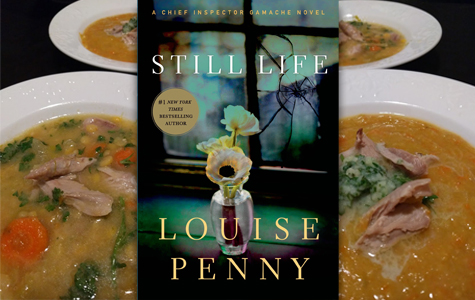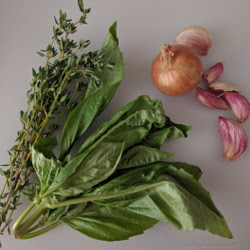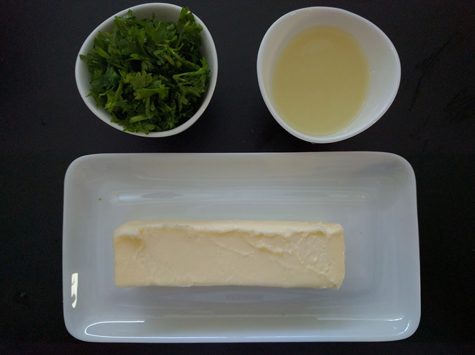
I have a confession to make: The first Louise Penny book I read was How the Light Gets In, and it was terrific (and I had the privilege of reviewing it for this site). But, I must also admit that my admiration felt distant. I didn’t already know the people in the book, and so I didn’t feel a lot of the personal nuances—the delight, the anguish—that come from diving back into a beautifully realized world and taking up with vivid, beloved characters once more.
For one reason or another, I never had the chance to go back and start the series properly, from the beginning. But then Macmillan published The Nature of the Feast, the companion cookbook to the Inspector Gamache series, and my editor suggested I do a run of Cooking The Books columns for it. No need to ask me twice!
I dove into the first book in the series, Still Life, eager to fill in the gaps of my Three Pines education. I already knew to expect something excellently plotted, with complicated twists, sympathetic characters, and an abiding belief in human goodness. I found all this and, to my surprise, a lovely, whip-smart humor that had been—almost of necessity given the desolation and betrayals of How the Light Gets In—largely missing from my earlier experience with Ms. Penny.
And oh, what a wonderful book Still Life is. You’d think that, given the focus on art in the book, the title refers to a kind of painting. But then you read the wonderful passage where Inspector Gamache is talking with retired psychiatrist-turned-bookseller, Myrna Landers, about the kind of stunted growth that forms a murderer, and you realize that that’s what it really refers to—an aversion to interior change that allows evil to flourish in one’s soul.
Ostensibly a mystery where Chief Inspector Armand Gamache of the Surêté du Québec comes to the village of Three Pines to investigate the suspicious death of a beloved local woman in what might be a hunting accident, Still Life is really a meditation on art and change and the enduring, decades-long bonds of friendship and kinship.
Then, of course, there's the food—the loving, delightful descriptions of French-Canadian food—and now, with The Nature of the Feast, accompanying recipes. For Still Life, the cookbook offered up a “Roast Turkey with Chestnut Stuffing” that I simply could not countenance making in DC’s summer heat. I tried this out instead:
French Canadian Pea Soup
*Makes about 10 cups (2.5 liters)
Ingredients

2 large ham shanks (about 1½ pounds/700 g)
6 cups (1.4 liters) chicken broth, preferably homemade, or water, plus more as needed
3 celery stalks, trimmed and coarsely chopped
2 small leeks, trimmed of roots and dark green leaves, white and light green parts coarsely chopped and washed well (about 3 cups/750 ml)
2 medium carrots, peeled and coarsely chopped
1 pound (450 g) split yellow peas, lightly rinsed and checked for stones
Freshly ground black pepper
Sea salt, if necessary
For the herb butter (optional)

6 tablespoons (3 oz/85 g) unsalted butter, at room temperature
¼ cup packed finely chopped fresh flat-leaf parsley or mint leaves
Finely grated zest and juice of 1 lemon
Instructions
1. Put the ham hocks in a large (6-quart/6-liter) soup pot. Pour in the chicken broth or water. There should be enough liquid to cover the hocks; if not, pour in water as needed. Bring to a boil, and then adjust the heat to achieve a simmer. Cover and cook until the hocks are barely tender when poked with a fork or paring knife, about 45 minutes. Transfer the hocks to a plate and let them cool as you continue with the soup.
2. Add the celery, leeks, carrots, and split peas to the hock cooking liquid. Return to a boil, adjust the heat to achieve a simmer, and cover the pot. Cook until the peas are tender, about 30 minutes. There should always be enough liquid to cover the peas by about 1 inch (3 cm). If not, add more broth or water as necessary.
3. As soon as the ham hocks are cool enough to handle, pull off all the meat and shred it very coarsely. If you like, return the bones and skin to the pea soup while the soup finishes cooking.
4. Make the herb butter: In a bowl, beat the butter, parsley or mint, lemon zest, and lemon juice together until smooth. Set aside at room temperature.
5. When the peas and vegetables are tender, you may leave them as they are—chunky—or use an immersion blender to smooth out the soup a little. (If you returned the ham bones and skin to the soup, remove them before blending.) Alternatively, ladle some of the soup into a regular blender and blend until smooth. Add the shredded ham and season with salt and pepper to taste. The soup can be made up to 2 days in advance. To reheat, bring to a simmer over low heat, adding water to thin it out if necessary. Whisk in the herb butter, if using, just before serving, or pass it separately. Very thin slices of pumpernickel or rye toast would be welcome.
Not being a ham eater, I substituted turkey legs, which imparted a similar smoky, meaty flavor (though one of my test eaters said she could see where ham hocks would have added an additional sweetness). I also decided to enjoy this soup with dinner rolls (or French rolls? Which is what I always thought dinner rolls were, but which notion local grocery stores have been recently disabusing me of,) as mentioned in the text of the novel, instead of the thin toast slices suggested above.
And let me tell you, “enjoy” was the operative word here! I definitely preferred the chunky version to the pureed, if only because the peas still retained chewier bits when blended, and I’m not a fan of that kind of variation in texture. The soup actually reminded me a lot of harira or mulligatawny, but exceeded either, primarily due to the whisking in of that incredible lemon butter. Regular readers will note that I once again failed to properly account for zest when compiling my shopping list (and thank goodness I had lemon juice in my refrigerator already). I also had that moment of cognitive dissonance upon realizing that the soup would not be green, as English and American cuisine would usually have a pea soup.
But, that’s the beauty of writing this column: I get to discover all these wonderful recipes, cultural mores, and—best of all—excellent books and then share them with you. Please feel free to cook along with me and comment on your own experiences, below or in my upcoming columns, as I cook my way through The Nature of the Feast and read my way through the Inspector Gamache series. You can download the cookbook here.
Next week, I’ll be talking about A Fatal Grace and making the “Buche de Noel,” yum yum!
To learn more or order a copy, visit:
Doreen Sheridan is a freelance writer living in Washington, D.C. She
microblogs on Twitter @dvaleris.
Read all posts by Doreen Sheridan for Criminal Element.

I printed the cookbook but the shading and small print was to difficult to read. Any advice?
Definitely check to see if your printer has black and white/greyscale, as well as enlarged options for printing. Best of luck, and let me know how your cooking turns out!